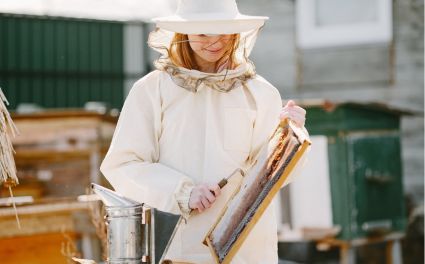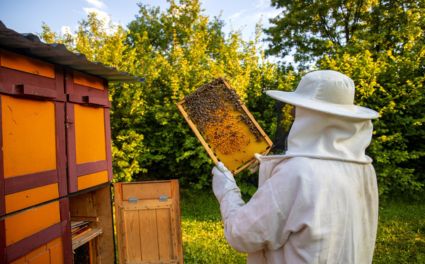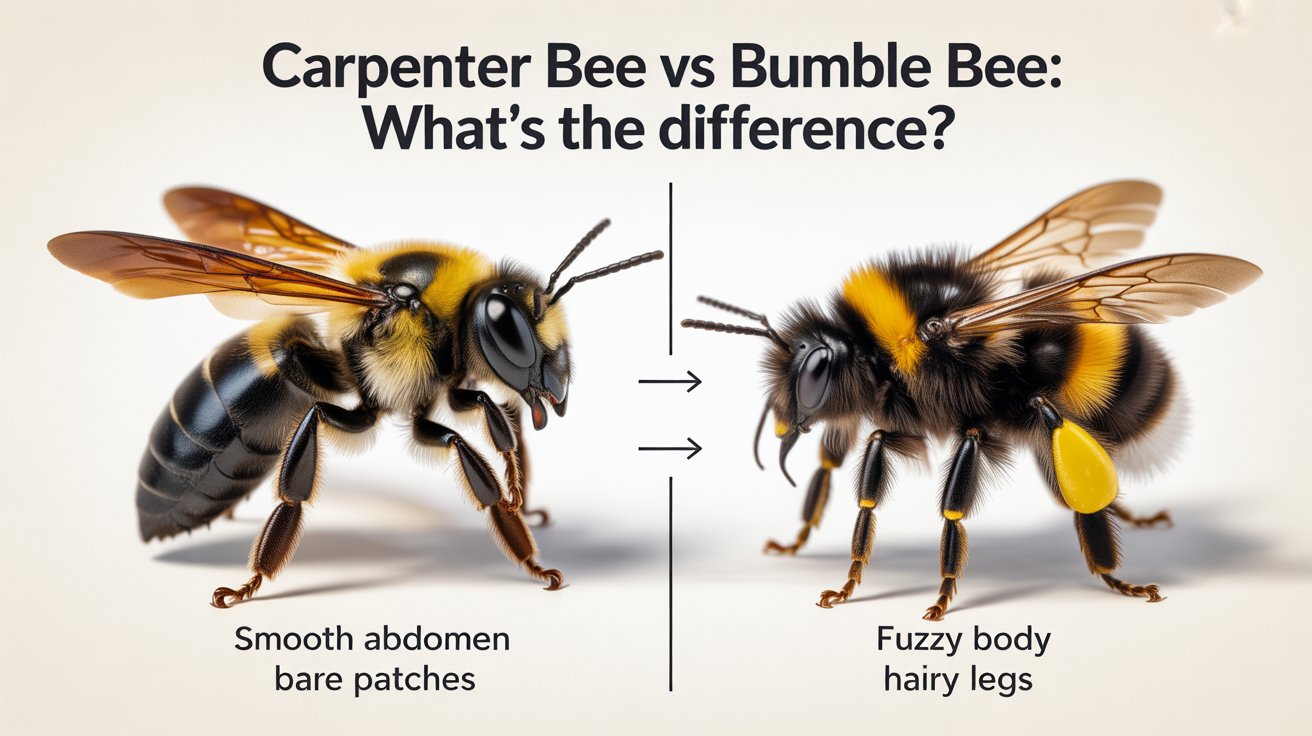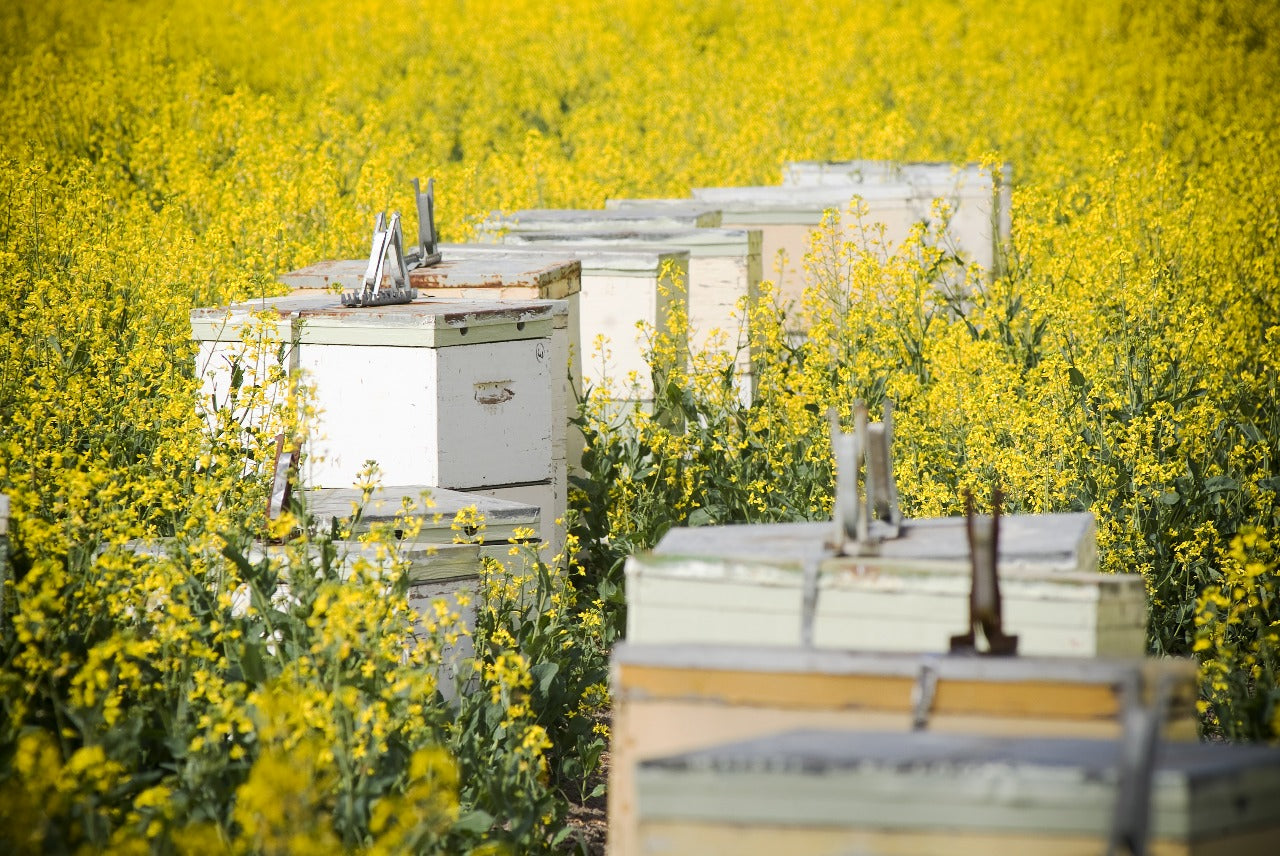Bees are vital for pollination, food production, and maintaining the natural balance of ecosystems. However, not all bees are the same — and among the many species, carpenter bees and bumble bees are often confused due to their similar appearance.
Despite their resemblance, these two pollinators have different lifestyles, nesting habits, and roles in nature. Understanding their differences not only helps in identifying them but also highlights their ecological importance.
Physical Characteristics
At first glance, carpenter bees and bumble bees look quite similar, but a closer look reveals several key distinctions.
Carpenter Bees
Carpenter bees are usually large and shiny, with a smooth, black abdomen measuring about one inch long. Their thorax is covered in dense yellow or golden fur, while the abdomen remains hairless and reflective — one of their most defining features.
Males have a light yellow patch on their face, unlike females, who have all-black heads.
Bumble Bees
Bumble bees, in contrast, are smaller and furry, with bright yellow and black stripes covering their rounded bodies. Their thick coat of hair helps them survive colder temperatures and continue pollination early in spring and late into autumn.
Their abdomens are covered in fine fuzz, unlike the carpenter bee’s sleek surface — making identification fairly simple once you know what to look for.
In short, remember this:
🟡 Carpenter bee → shiny abdomen
⚫ Bumble bee → fuzzy abdomen
Also read: How does a bee become queen?

🏡 Behavior and Nesting Habits
Carpenter Bees – The Solitary Architects
Carpenter bees are solitary insects that prefer nesting alone. True to their name, they drill small circular holes into untreated wood to create tunnels where they lay eggs and store pollen.
They don’t actually eat wood — they simply excavate it for nesting. While male carpenter bees don’t sting, females will sting if threatened, though they rarely do.
Because of their wood-boring behavior, they may cause minor cosmetic damage to decks, beams, or outdoor furniture. However, the tunnels are shallow and seldom pose a structural risk.
Bumble Bees – The Social Workers
Bumble bees live in organized colonies, usually in underground burrows, grassy mounds, or abandoned rodent holes. Their social structure includes a queen, worker bees, and drones.
They work cooperatively to build and maintain the nest, forage for food, and raise young. Bumble bees also exhibit complex communication patterns, such as using scent and vibrations to share foraging information.
These bees play an essential role in natural and agricultural pollination thanks to their teamwork and long foraging periods.
🌼 Role in Pollination
Carpenter Bees
Carpenter bees are highly efficient pollinators for tubular flowers such as passion flowers, wisteria, and some fruit trees. While they can sometimes “rob nectar” by biting through the base of flowers, they still contribute to pollen transfer and overall plant reproduction.
Bumble Bees
Bumble bees, however, are considered masters of pollination. They perform a unique method called buzz pollination, vibrating their flight muscles to release pollen from deep within flowers.
This makes them especially valuable to crops like tomatoes, blueberries, and peppers. Their hairy bodies also trap and carry more pollen per trip, increasing fertilization rates across a variety of plants.
🧍♂️ Interaction with Humans and Environmental Impact
Carpenter Bees and Wooden Structures
While carpenter bees play a valuable ecological role, they sometimes become unwelcome guests near human habitats. Their nesting behavior can cause mild surface damage to untreated wood, but this can easily be prevented by painting or sealing exposed surfaces.
Providing wooden bee houses or bamboo tubes can also divert them from drilling into structures.
Bumble Bees and Gardens
Bumble bees, on the other hand, are gardeners’ allies. They enhance pollination in fruit and vegetable patches, improving yields naturally. Generally gentle, bumble bees rarely sting unless provoked or if their nest is disturbed.
Their ecological contribution far outweighs any inconvenience.
Also read: Why do bees make honey?
⚙️ Conservation and Protection
Protecting Carpenter Bees
Conservation of carpenter bees is vital because they pollinate plants that many other insects cannot. Building safe nesting sites, such as untreated wood blocks or artificial bee houses, encourages them to stay away from human structures while thriving naturally.
Promoting pollinator-friendly gardens filled with native flowers also supports their survival.
Protecting Bumble Bees
Bumble bee populations face challenges due to habitat loss, pesticides, and climate change. Supporting them means growing diverse flowering plants, avoiding harmful chemicals, and maintaining undisturbed natural areas.
Encouraging community awareness and sustainable gardening practices helps preserve both species for generations to come.
🧰 Safety and Beekeeping Equipment
Whether observing bees in your garden or maintaining hives, safety and comfort should always come first. Using the right beekeeping equipment ensures protection during close interactions with bees.
Essential gear includes:
-
Beekeeping Suits: Full-body suits offering maximum sting protection for professional or hobbyist beekeepers.
-
Beekeeping Jackets: Lightweight options for easier movement during inspections.
-
Beekeeping Gloves: Protects your hands while maintaining grip and control.
-
Beekeeping Veils: Essential to protect the face and neck area.
-
Beekeeping Trousers: Adds flexibility and comfort while ensuring sting-proof protection.
-
Beekeeping Kids Suits: Designed for young learners who are exploring the wonders of bees safely.
-
Beekeeping Ankle Protection: Prevents bees from crawling up through cuffs or boots.
-
Beekeeping Equipment & Tools: Includes smokers, hive tools, and accessories that help manage colonies efficiently.
Trusted brands such as Oz Armour are well-regarded globally for crafting ventilated, durable, and high-performance protective wear. Designed for comfort and confidence, their gear allows beekeepers to focus on their bees — not the stings.
🌺 Bee Identification and Beekeeper Awareness
For anyone involved in pollination or hobby beekeeping, identifying bees correctly is essential. Knowing whether a bee is a carpenter or bumble bee can guide how to manage their presence:
-
Carpenter bees may require wooden protection measures.
-
Bumble bees, being social and beneficial, can be encouraged to stay in gardens.
When inspecting hives or observing wild bees, always wear your protective suit, gloves, and veil to ensure safety while learning about these fascinating creatures.
If you’re just starting, investing in quality beekeeping equipment ensures a positive, sting-free experience from day one.

🌳 Why Both Species Matter
Both carpenter bees and bumble bees play unique roles in the environment. While carpenter bees are expert wood nesters and pollinators of deep-flowering plants, bumble bees are powerhouses for agricultural pollination.
Together, they contribute immensely to biodiversity and food security. Their survival supports not only ecosystems but also human livelihoods that depend on crop yields and healthy flora.
Conservation efforts — from sustainable gardening to responsible beekeeping — ensure these pollinators continue to thrive.
🌼 Final Thoughts
Understanding the differences between carpenter bees and bumble bees helps us appreciate the complexity and beauty of nature. Carpenter bees may cause mild wood damage, while bumble bees boost agricultural productivity through efficient pollination — yet both species are indispensable to the environment.
For those exploring the world of bees, proper beekeeping suits, jackets, and protective equipment make the experience both safe and enjoyable. By using reliable gear from trusted sources like Oz Armour, beekeepers and enthusiasts can engage confidently with nature’s most remarkable pollinators.
To continue your learning journey, you can read more blogs about beekeeping and explore expert insights on bee behavior, hive safety, and sustainable pollination practices.
Every bee — whether a solitary carpenter or a social bumble — plays a role in keeping our planet thriving. Protect them, respect them, and work alongside them for a greener future.













